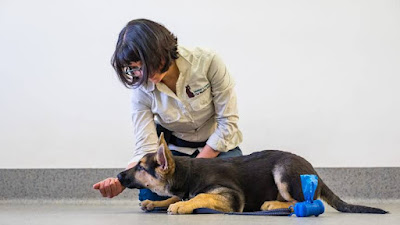Have you ever wanted to get a puppy? If so, you might be wondering how to go about training them. Your puppy's age will have an effect on what kind of training you can do. Here are some general guidelines for how to train your puppy at different ages. 0-2 months: This is the time for socialisation and exposure to things that they're not used to seeing. You'll want to get them used to being around people, noises, new surfaces, etc. 3-5 months: This is when the housebreaking aspect of training will start coming in more prominently. 6-7 months: At this point, your pup should be more focused on obeying commands and learning more difficult tricks. 8+ months: You can.
Puppies and Socialisation
Your puppy's age will have an effect on what kind of training you can do. Here are some general guidelines for how to train your puppy at different ages. You'll want to get them used to being around people, noises, new surfaces, etc. at different ages. You'll want to get them used to being around people, noises, new surfaces, etc. Their food will change as well. Some breeds, such as chow chows, may begin chewing on your shoes if they don't get fed on time. Your puppy will need to learn when to stop chewing things and when it's okay to chew. When they're young, you'll want to be sure that you clean up their messes right away, but once they've gotten some experience, you can give them more freedom.Housebreaking
In terms of training, there are some things you can do at any age. The big thing that should be done at this point is introducing your puppy to the concept of "go to the bathroom" and "go outside" as well as simple things like teaching them to stay in the yard and not chew up the house or dig in the yard. The more they're exposed to things and comfortable with them, the better the future for you and your puppy will be. Feeding Once your puppy is able to eat properly, they will need to learn how to do it in a safe environment. A puppy can be easily overwhelmed by a full belly, so you need to start small with your puppy.Potty Training
Potty training is a phase in which you teach your dog to use the bathroom outside, not inside the house. At first, your dog will not be able to make it to the bathroom before it gets the urge. To help your dog learn how to use the bathroom outside, you will want to use treats when he goes to the bathroom outside. Use praise, treats, praise, etc. to encourage your puppy to go outside to use the bathroom. 6-9 months: Once your puppy gets the idea of using the bathroom outside, you will want to move on to taking him out less frequently. A training schedule for this phase can be found here. 1-3 years: Once your dog is ready to go on an outing and isn't having accidents in the house, you can gradually start taking him to more public places.Puppy training schedule
Use the following schedule to get your puppy used to the schedule that you'll want to have during his/her adult life. Early morning: Give your puppy food and water. This is the time to practice recall. Put them in the backyard, let them see their toys, etc. Spend some time teaching them how to come when called. Exercise! You can start by walking around the block. Get your pup used to having to go out early in the morning. Continue this every morning for a couple of weeks. Feed your pup. Have them go outside and see their toys. Give them a treat every time they go into the correct behaviour. Then, do the same with their crate. Take them outside when you say "potty". After five to 10 minutes, praise them. This teaches them that going outside is a desirable thing, and is a good sign.
READ MORE:
- Dogs Behaviour Explained: The 5 Most Common Dog Behaviours And What They Mean
- 4 Reasons Why Dog Whiskers Are Very Important To Dogs
0-2 months
The entire first two to three months of training are about getting your puppy accustomed to the house. As you can see from the puppy's behaviours, it's only just now beginning to think about how it interacts with other objects, people, and things. You'll want to make sure you're consistent with your puppy's schedule, to ensure you aren't overwhelming them. You'll also want to make sure that your puppy has plenty of toys and activity time in between play sessions. There are some basic rules you'll want to follow when training your puppy. One of them is the "rule of three". The rule of three is that when training your puppy, you want to reward them with something when they do something the first time.
3-5 months
Puppies are learning to use the potty training method that you're going to use. By that time, your puppy is nearly 9 weeks old. Puppies will be going through the process of learning to not urinate and defecate on the floor. This will start to involve having to walk your puppy and having them go on a leash when you want them to use the toilet. You'll want to teach them that the places you go to the bathroom should not be the places they urinate and defecate. 4-5 months: This is when you will want to start teaching your puppy the command to "Go potty." All you need to do is have them sit and look at you. This is so they learn that, when they need to go potty, you need to show them where to go. This part of the training is extremely important to them.
6-7 months
9-12 months: At this point, you should start to introduce rewards. In addition, you can start teaching basic commands to your puppy. 13-15 months: At this point, you'll be looking at the most common obedience commands, like sitting, staying, and waiting. If you have any pets already, they should be over the age of 12 months at this point, so you can get them trained with your new puppy. 16-18 months: At this age, you should start working on picking up and holding your dog for longer periods of time. Your pup should also be walking nicely on a leash. 19-22 months: At this age, your pup will be fully housebroken and should be a solid walker on a leash. Your pup is now considered full grown, and it's time for you to get serious about training.
8+ months
Things start to get more complicated at this age, as the process of learning can start to slow down. Your puppy will still need some attention, as they're no longer getting a ton of physical stimulation. You'll also be exploring new training and socialisation opportunities, which can be difficult for some young dogs. This is also the time when you should start looking for your new dog's training team. Keep reading to learn more about getting a puppy training schedule and how to train your puppy at different ages. Things start to get more complicated at this age, as the process of learning can start to slow down. Your puppy will still need some attention, as they're no longer getting a ton of physical stimulation.
Conclusions
When you bring home a puppy, it's important to set a plan in place that you can follow to ensure that your dog gets the correct amount of exercise and attention. You need to take care of your puppy, but you also need to think about the rest of your household. By following these guidelines, you'll be able to establish the best way to train your puppy.








0 Comments